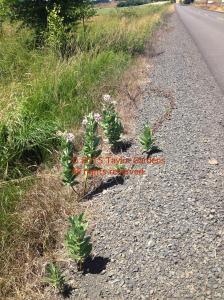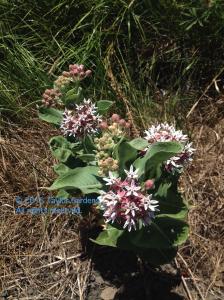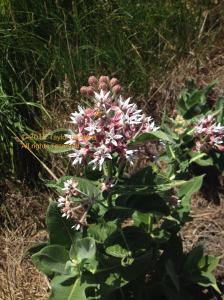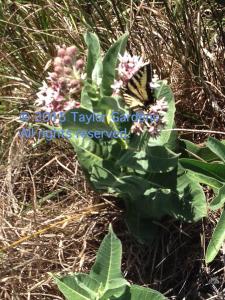Monarchs are probably the best ambassadors for conservation. They are popular, great looking, and they need habitat from their wintering forests in Mexico all the way to Canada. Here on the west coast we have our own population that winters in California. Because the midwestern migration route can be as long as 3000 miles, if farmers can be convinced to use farming practices that help monarchs, it helps a ton of other species, over a huge area. This means no Roundup Ready crops, because that means no weeds on the margins of agricultural fields, and that is where the monarchs are. Even better is organic farming with hedgerows, beetle banks, conservation cover, and windbreaks with some evergreen trees. By advocating for uncultivated margins, Aldo Leopold had the formula in the twentieth century.
Monarchs are dependent on milkweed (Asclepias sp.) because their caterpillars only eat milkweed. Adults lay their eggs on milkweed as they make a multi-generational journey from Mexico each year.
As Monarchs head north, they feed on nectar, stopping at night in protective tree canopies. The first and second generations from Mexico will die before the population gets where it’s going. After newly transformed butterflies emerge from chrysalises they continue on their leg of the migration relay. There may be three or four generations of butterflies by the time the population reaches the farthest point in their travels. In the fall, the last generation will travel all the way back south, looking for sustenance along the way. After overwintering as adults, they will head north again. It’s amazing that this works at all!
Here is an awesome time lapse of the entire monarch lifecycle.
If you’d like to have a look at some nice milkweed and possibly an egg, caterpillar or monarch, check out the gardens at Winter’s Hill Winery and Vineyard. (That is some butterfly-friendly wine, and so delicious!!)
I recently found these clumps of milkweed on the side of the road:
If no one sprays it before it goes to seed I will collect seed and grow out plants next year. Having planted a few this year, I can say they are a bit slow to get going but once established they thrive on neglect. A seasonally wet ditch in the sun is best. A wet prairie is ideal. That way the monarchs can find them.
While I was photographing these clumps, a honeybee and a western tiger swallowtail butterfly came by.





Yes! That would be fun.
LikeLike
Mom’s place in Gopher Valley has never been sprayed with pesticides in the 57 years she has lived there. It may harbor about any plant–native or otherwise–you are interested in observing and/or propagating. We should connect next week!
LikeLike
Thanks for your post about milkweed. There must be some at my mother’s place in GV; will ask her about it next week while visiting. Maybe if enough of us propagate milkweed plants in our yards we can help offset the rampant destruction of habitat by the human forces of greed.
LikeLike